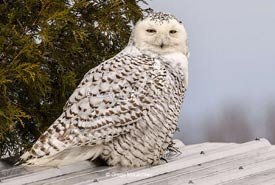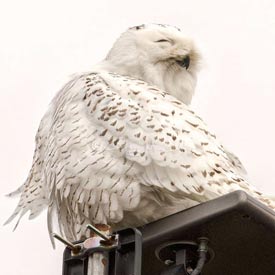On the trail of snowy owls

Snowy owl (Photo by Gregg McLachlan)
When I got an inside tip in late December that numerous migrating snowy owls were being spotted near Long Point, Ontario, I knew I had to grab my DSLR, 600mm lens, fingerless gloves, four layers of clothing, and get down there fast. The Long Point coastline of Norfolk County can feel like the Arctic on a winter day, as bone-chilling west winds sweep across Lake Erie.
But you quickly put the cold out of your mind. After all, these are snowy owls.
Everyone has their Holy Grail species. For me, snowy owls are right up there for must-see animals in the wild. There’s something magical about staring directly into the heart of those big yellow eyes. And, you never know when you will see one again. The recent winter migrations (or invasions as they are dubbed) of snowy owls into more southerly regions are erratic.
As I cruised across the narrow causeway linking the mainland to Long Point, I looked at every telephone pole bordering the inner bay of Lake Erie and the marshlands — all prime areas for snowy owls to sit and survey the area for unsuspecting water birds and swoop in for a quick meal. But there was nothing. Immediately I sensed this could be a fruitless expedition.

Snowy owl on a post (Photo by Gregg McLachlan)
I needed a Plan B if this day was to reveal some snowies. So I drove another several kilometres. I knew of a sheltered area with views of the bay. If there was another prime spot where owls might perch to look at the open waters of the Lake Erie inner bay marshes, this would be it.
I entered a quiet area of shuttered cottages and boathouses. Within seconds, sitting atop a television antenna was the prize. It was a beautiful juvenile female snowy owl. I jumped out of my car, set up my tripod and started to click and observe. The one thing you quickly learn about wild snowy owls is their unfamiliarity with humans. They do not flee at our sight because in their prime habitats in the north they do not come into contact with us much. This one was no different. It was curious of my presence, but went about its preening like I wasn’t there. Still, it's important to be respectful and minimize your time in their presence and your distance at all time when photographing and viewing wildlife.
Twenty minutes later it was time to move on. I really wanted to photograph a snowy owl in a tree. Anything natural. A television antenna just doesn’t cut it.
My eyes darted back and forth at every boathouse, the treeline, and cottage rooftops.
“There’s one!” I whispered excitedly. “There’s another one!”
In the span of about 50 metres, there were five snowy owls.
This was truly an incredible day.
Seeing one snowy owl in Norfolk County during the recent winter migrations is a great sighting.
Seeing five within 50 metres is like the Super Bowl of snowy owl sightings here.
My best encounter was with a juvenile owl sitting on a boathouse toolshed. I was able to quietly approach within about 30 metres, the whole time using some obstacles as mini blinds to minimize my slow approaching presence. My 600mm lens did the rest. I wrapped up the day with an encounter I will never forget. Locking eyes with a wild snowy owl is something that is forever stored in your brain as a jpeg.
Just days later, I learned that the owls had moved on. A suddenly frozen bay meant the owls’ food sources had left the area to search for open water.
It could be years before I see this many snowy owls in one place at the same time. That’s OK, though. This year’s encounter will tide me over until the next time.
Until that happens, I have one incredible day with nature that will stay with me for the rest of my life.


